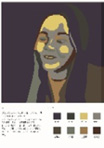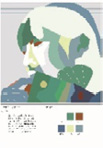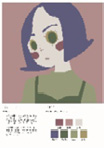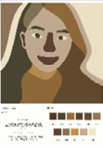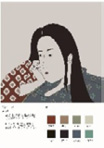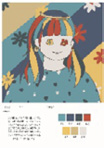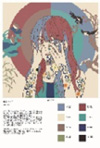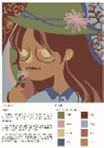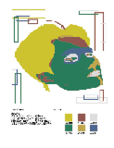Vol. 8, n. 1, aprile 2022
TEORIE E MODELLI DIDATTICI
Analisi e applicazione dei colori delle opere d’arte
Risvegliare il senso estetico per i colori e l’abilità narrativa degli studenti tramite le opere del National Palace Museum a Taipei
Ching Chih Liao1
Sommario
Come osservato da molti, l’esperienza estetica e la consapevolezza dei colori estetici è piuttosto limitata tra i nuovi studenti universitari di design, e l’uso frequente dei cellulari e dei social media intacca la loro capacità narrativa. Pertanto, le unità per un necessario corso di «Teoria del Colore» sono state create allo scopo di coltivare l’esperienza estetica del colore e la capacità narrativa di questi studenti. I colleghi hanno esaminato un tema e un argomento narrativo, il disegno di un autoritratto, la denominazione e l’abbinamento dei colori, nonché un’autovalutazione del proprio apprendimento. I risultati della ricerca mostrano che questo design educativo aiuta a migliorare l’associazione dei colori e le capacità di abbinamento dei colori degli studenti, e potenzia la loro esperienza estetica, con correlazioni altamente positive. Tuttavia, la correlazione tra capacità narrativa, abbinamento dei colori e capacità di associazione dei colori da una parte, ed esperienza estetica dall’altra è relativamente debole. La prima correlazione suggerisce la direzione futura dell’insegnamento della Teoria del Colore, mentre l’ultima illustra il bisogno di rinforzare ulteriormente la capacità narrativa.
Parole chiave
Teoria del colore, Esperienza estetica, Capacità narrativa, Abbinamento dei colori, Valutazione dei colleghi.
THEORIES AND DIDACTIC MODELS
Analysis and Application of Artwork Color
Awakening Students’ Color Aesthetics and Narrative Ability through Artworks at the National Palace Museum in Taipei
Ching Chih Liao2
Abstract
As many observe, aesthetic experience and awareness of color aesthetics is rather limited among new university design students, and their frequent use of mobile phones and social media erodes their narrative ability. Therefore, units for a required Color Theory course were designed based on cultivating the color aesthetic experience and narrative (storytelling) ability of these students. Peers evaluated naming a theme and theme story narration, self-portrait drawing, color naming and color matching, as well as completed a self-evaluation of their own learning. Research results show that this instructional design helps to improve students’ color association and color matching abilities and enhances their aesthetic experience, with significant highly positive correlations. However, the correlation between narrative ability, color matching and color association abilities, and aesthetic experience is relatively weak. The former suggests a future direction in the teaching of Color Theory, while the latter illustrates a need to further bolster narrative ability.
Keywords
Color theory, Aesthetic experience, Narrative ability, Color matching, Peer evaluation.
Introduction
Aesthetic experience is essentially an emotional and perceptual experience (Lin, 2009), a complete experience (Dewey, 1980). Considering new university students have been living under the pressure of being accepted at a tertiary institution for a long time, their aesthetic experience and stimulation from color aesthetics in daily life is rather limited. If students lack aesthetic experience, have poor imagination and low perception in daily life, how can they start thinking creatively and create a moving brand story? Therefore, educators have the responsibility to play their role in designing appropriate teaching materials, so that university freshmen can through the learning process, truly observe daily life, regain their sensitivities, and awaken color awareness.
Furthermore, there is concern that the new generation uses electronic telecommunications products frequently and the amount of reading is reduced, so narrative ability suffers. Good expression and communication skills are qualities that a good designer should have, so curriculum design should foster these as well as allow design students to experience daily beauty; awaken color perception and color matching acuity. Cultivating the ability to express thoughts in written words or oral communication is extremely important, especially in the face of the artificial intelligence trend. As human beings, it is essential for designers to cultivate abilities that cannot be replaced by machines.
Therefore, in order to initiate the freshmen aesthetic experience, color ability and enhanced narrative ability are set as the teaching basis of this course. Storytelling and peer evaluation are introduced as the teaching method and evaluation strategy for this Color Theory course. The purpose of this teaching research is to observe: 1) Whether this instructional design helps to improve students’ narrative and color matching abilities; 2) Whether there is a correlation between narrative (storytelling) ability and color matching performance ability.
Narrative Ability and Storytelling
According to Taiwan Ministry of Education’s «Innovative Group Curriculum Program for the Integration of Professional Knowledge and Narrative Ability», the current goal is to cultivate a comprehensive combination of competences in correct listening, extracting, reading, writing, oral presentations (short lectures), and communication (Taiwan Ministry of Education, 2016). Narrative ability is as the basic method for human thinking and organizing knowledge. It is clearly shown that people think, express, communicate and communicate in a narrative way in daily life as a means to understand people and events (National Academy for Educational Research, 2021). However not everyone has good narrative skills to cope with study, work or life. Some people are even unable to integrate what they have learned into daily work or life, as shown by Berryman (1991). This problem gradually attracted the attention of relevant scholars after the late 1990s.
Therefore, scholars have successively applied narrative or narrative analysis to different fields, or have used visual narrative research methods to explore the causes of low modeling creativity in ceramic art (Lee, 2019). Some have also applied these methods to cross-disciplinary learning, combining tourism, food, with the reading of literature, hoping to train students to have the aesthetic narrative ability for creative expression and humanistic care (Wang, 2016). Others have integrated marketing expertise into narrative training, based on the story map style theory to guide students to design story marketing (Tsai, 2020).
Narrative or narrative analysis is a methodology that studies the narrative logic of people telling stories. Narrative analysis is a form of narrative experience. It can be seen that storytelling is a specific action of narrative behavior, and there are multiple ways of telling stories, as they can be written, spoken, or performed. According to Livo and Rietz (1986), a story is a reorganized daily experience. Through story, it is easier for people to understand and remember things.
Aesthetic Experience
Silverman (1997) believed that aesthetic experience in learning is a cognitive function that combines emotion and cognition, while Broudy (1988) believed that aesthetic experience permeates everywhere like cognition and practical activities. If it can foster students’ feelings and performance abilities, this is their experience. Eisner (2002) pointed out that as long as the core values of school education change, aesthetic experience can be practiced in school education; these changes include more emphasis on inquiry rather than discovery.
Aesthetic experience has different characteristics in each subject (Lin, 2012; Lin, 2009; Zhou, 2011). This teaching research was initiated in order to understand the characteristics of aesthetic experience in a Color Theory course. The project focuses on the stimulation of color perception, inspiring students to observe and explore extensively, and then attain the experience of multiple color matching.
Color Matching Theory
Van Gogh once said: «There is no bad color, only a bad combination», which illustrates the importance of color matching. The ultimate goal of color matching is to harmonize, and harmonization refers to making two or more adjacent colors appear to produce a pleasant effect (Judd and Wyszecki, 1975; Granville, 1987). Bottomley and Doyle (2006) mentioned that when the emotional value of product positioning and the feeling about a product are linked together, the higher the color consistency, the more the sales rate can be increased.
Color matching is so important that a number of color matching theories have been proposed. Goethe (1840), Chevreul (1860), Munsell (2019), Itten (1975) and others have all had their own differing but close views on color matching. Fusion of the above-mentioned views, especially Chevrolet’s view on color matching, has become the generally accepted modern color matching principle (Wei et al., 2019): 1) colorless with color; 2) similar hue with similar color matching method tone (tone in tone); 3) same hue-dark greyish vs. bright (tone on tone); 4) different hue with same tone (tonal). Color matching skills also involve changes in harmonizing attributes, such as area, association interaction, etc., as these will also affect the color matching effect. It can be seen that the color matching method can follow theoretical principles or be compiled through experience. Savoring the aesthetic attitude of things in life can also inspire color matching.
Method
Teaching Design and Research Design
This teaching plan comprised three units: 1) color theory; 2) topic discussion; 3) practical color application. This research focused on a specific unit of practical training in Color Theory. The design of this practical unit allowed students to choose a Taipei Palace Museum artifact or painting for color analysis and learn to name colors. Before analysis, they were to read and understand the era and creator of the work as well as background information related to the piece. Then, the student proposed a self-portrait theme, narrated a theme story, and applied color to their self-portrait according to the proportions of various colors on the artifact or painting. The experience sharing of color matching methods; students responded in the discussion area of the E-teaching platform provided by the university; and the volume of information in the discussion area was so large that it was not included in the scope of this paper.
Finally, a total of 10 works were selected for production of a questionnaire divided into two parts: self-portrait evaluation and self-learning evaluation. Referring to Lin’s (2012) scale on the development of learning indicators in the field of aesthetics in the syllabus of Taiwan’s kindergartens, quantitative measurement for the content of the two parts of the questionnaire was drawn up. The total of 12 questions covered aesthetic attitude, color matching performance (including color awareness, color emotion, color association), narrative ability (including color naming, proposition, story writing), and self-learning evaluation topics. The collected data was tested by the repeated measure ANOVA, one sample t-test, and Person correlation coefficient test.
Participants
Most of the participants were first-year students from the Commercial Design department, with a small number from other departments. There were 63 students in total, with an average age of 19,23, SD=0,83.
Stimuli
From the work of 63 students, the performance of students’ work was divided into three levels: high, medium, and low. Two research assistants selected three works from each of the three levels (four where there were more excellent works). A total of 10 works (figure 1), numbered from No,1 to No,10, were combined with 7 questions evaluating the works to design a questionnaire as a data collection tool.
|
|
|
|
|
|
|
No,1 Singular |
No,2 Fresh |
No,3 Bud Released |
No,4 Maiden |
No,5 Deep |
|
|
|
|
|
|
|
No,6 Banquet |
No,7 Floating Flower |
No,8 Pattern |
No,9 Flower Edge |
No,10 Spread |
Experiment Sample Set.
Questionnaire Design
According to the literature, the operative definition of narrative ability used herein is the ability to name colors, propose a theme, and develop a story along a theme. Then, referring to the scale used by Lin (2012), the quasi-quantitative measurement questions comprise items on: aesthetic attitude, color matching performance, narrative ability etc.
Finally, a total of 7 items were drawn up for the evaluation of the work: Q1: creativity of proposed theme; Q2: creativity of story narrative; Q3: fluency of story narrative; Q4: creativity in color naming; Q5: drawing skill on self-portrait; Q6: alignment of color use on self-portrait with the artistic conception of the story; Q7: harmony of color matching on self-portrait. In addition, there were 5 items for self-study evaluation: Q8: Improvement of my color matching ability through the analysis of artifacts and self-portrait drawing (which can reflect the impressions of harmony and coordination); Q9: Improvement of my color association ability through the analysis of artifacts and self-portrait drawing; Q10: Stimulation of narrative ability of storytelling through the analysis of artifacts and self-portrait drawing; Q11: Stimulation of narrative ability of color naming through the analysis of artifacts and self-portrait drawing; Q12: Enhancement of color aesthetics experience through the analysis of artifacts and self-portrait drawing. The selected self-portraits numbered from No,1 to No,10 were combined with the first 7 items on a Google questionnaire form. These items were measured using a Likert 7-point scale, where a score of 1 indicated a lower degree of affirmation, a score of 7 a higher degree of affirmation.
Procedure
For the scoring, participating students viewed the theme, story narration, color names, drawing skills, and color matching of each work to be evaluated, which appeared randomly. The evaluation of the 10 works was completed first, then students engaged in the self-study evaluation.
Results
A total of 63 data sets were collected, among which 4 participants had flaws in their data, so they were discarded and not included. Finally, 59 data sets were analyzed. The data was divided into two parts, one is work evaluation, and the other is self-evaluation. The analysis results are as follows.
Evaluation of works
It can be seen from table 1 that the performance of the 10 works yields F(9,522)=22,87, p=0,001 <0,05, partial η2=0,28, which means that there is a significant difference between at least two works. After Scheffe post hoc test, it is found that S8, S6, S3, S5, S9> S4, S1, S7, S2> S10, from the averages perspective; S8 (M=5,87), S6 (M=5,85), S5 (M=5,57), S9 (M=5,55) scores are higher. Notably, the two works S8 and S6 performed better on the seven items on average, with the themes of «Banquet» and «Pattern». The relatively low average of S10 (M=4,77) shows weak performance in all aspects; but it is still over 4 points of verification value. In other words, following this color practice exercise, the self-portrait works produced under the course design can lead to students being generally affirmed by their peers for theme proposal, theme narrative ability, color naming, image drawing and color matching ability.
From the results of using these seven items for evaluation (table 1), F(6,348)=17,58, p=0,001 <0,05, partial η2=0,23, shows a significant difference between at least two items. According to Scheffe post hoc test, it is found that Q7> Q 6, Q1, Q 5> Q 3> Q 4, Q2. from the averages perspective that the average score on each item exceeds 5, which means that the selected works are strongly affirmed by students. The performance on these seven items is substantially affirmed. Q7 (M=5,79) has the highest average score, which means that the 10 works are all highly affirmed on the seventh question (harmony of self-portrait colors). Relatively lower average scores were attained on Q3 (M=5,40) (fluency of storytelling ability), Q2 (M=5,26) (creativity of storytelling) and Q4 (M=5,24) (creativity of color naming); that is to say, students honestly reflect that there is still room for improvement on naming colors and storytelling skills.
Table 1
Works and Questionnaire Items ANOVA.
|
Effecs |
Sum of Squares |
df |
M Square |
F |
p |
Partial η2 |
|
A. Samples, n=10 |
364,913 |
9 |
40,546 |
22,877 |
,000*** |
,283 |
|
std dev |
925,159 |
522 |
1,772 |
|||
|
B. Evaluation Items, n = 7 |
130,895 |
6 |
21,816 |
17,582 |
,000*** |
,233 |
|
std dev |
431,791 |
348 |
1,241 |
Note: *** p<,001
Self-Evaluation
For the five (5) self-evaluation items, a one sample t test analysis is conducted first, then five (5) points are used as the test standard to test each item one by one. The analysis results for students’ self-evaluation can be seen in table 2. The p-value for response to all items is 0,001 <0,05, reflecting that the participating students highly confirm and accept that they have been trained through the assignment, that is to say, they agree that it can improve their abilities in color matching, color association, story narration, color naming, and further their aesthetic experience.
The data then underwent analysis for Pearson Correlation Coefficient, the results from which are shown in table 3. These results show that color association, r=,70, p=0,001<0,05 and enhanced aesthetic experience r=,71, p=0,001<0,05 have a significant high positive correlation with color matching ability, while story narrative ability, r=,40, p=0,01<0,05 and color naming, r=,30, p<0,05 have a significant moderate positive correlation with color matching ability.
Enhanced aesthetic experience, r=,64, p=0,001<0,05 is highly correlated with color association, while story narrative ability, r=,34, p=0,01 <0,05 and color naming, r=,47, p=0,001 <0,05 display a significant moderate positive correlation. Color naming, r=,42, p=0,001 <0,05 and enhanced aesthetic experience, r=,38, p<0,01 have a significant moderate positive correlation with narrative ability of storytelling. Enhanced aesthetic experience, r=,44, p=0,001<0,05 exhibits a significant moderate positive correlation with narrative ability of color naming.
In general, only color association, enhanced aesthetic experience and color matching ability have a significant and highly positive correlation. Color naming, proposal of self-portrait theme and narrative ability of storytelling are related to color association and aesthetic experience but show only moderate correlation. It can be said that narrative ability is relatively weakly correlated with color association and aesthetic experience.
Discussion and conclusion
Through the design of this teaching activity, using Taipei National Palace Museum cultural relics to awaken students’ color aesthetics and narrative abilities, students analyzed colors on artifacts or paintings, and then applied the same colors in like ratio to their own self-portrait. They then engaged in peer evaluation and self-evaluation. According to the analysis results, overall color matching application ability can be greatly improved; participants also affirmed that this activity can enhance their aesthetic experience. It is assumed that since the color matching is based on the analysis of the readily viewable museum works, and the color application is applied to the self-portrait according to the proportion of its appearance in the artifacts or paintings, and the reference object for the use of color is relatively handy, this can increase students’ proficiency. Reflecting on the creations of others is one of the ways to learn color matching. As students were encouraged to browse the National Palace Museum website carefully, reading about and viewing the cultural relics to choose an image for analysis, this was an eye-opener for freshmen. Therefore, the participants affirmed that such an experience was good for them and significantly enhanced their aesthetic experience.
Table 2
Self-evaluation one sample t test.
|
t |
d |
p |
mean dev |
|
|
Q8: Color matching ability |
10,077 |
58 |
,000 |
1,118 |
|
Q9: Color association ability |
10,991 |
58 |
,000 |
1,152 |
|
Q10: Narrative ability of storytelling |
3,763 |
58 |
,000 |
,525 |
|
Q11: Narrative ability of color naming |
7,300 |
58 |
,000 |
,966 |
|
Q12: Enhancement of color aesthetics experience |
11,079 |
58 |
,000 |
1,237 |
Table 3
Correlation matrix between narrative ability and aesthetic experience (n=59)
|
1. Color matching ability |
2. Color association ability |
3. Narrative ability of storytelling |
4. Narrative ability of color naming |
|
|
1. Color matching ability |
- |
|||
|
2. Color association ability |
,70*** |
- |
||
|
3. Narrative ability of storytelling |
,40** |
,34** |
- |
|
|
4. Narrative ability of color naming |
,30* |
,47** |
,42** |
- |
|
5. Enhancement of color aesthetics experience |
,71*** |
,64** |
,38** |
,44** |
Note: *p<,05 ** p<,01 *** p<,001
In comparison, there was no significant effect on students’ narrative ability, because that was not within reach in the short scope of this experiment. Cultivating narrative ability requires much daily reading, frequent training in abstracting and communication practice; over time, one can generally see the effects. Furthermore, although there is a correlation between narrative (storytelling) ability and color matching ability, it is not a significant high correlation. This needs to be strengthened for imagination and creativity.
In summary, color association ability is significantly and highly positively correlated with the enhancement of aesthetic experience and color matching ability. In future teaching, color association and color aesthetic experience can be strengthened to improve color matching ability. The close and highly positive correlation between enhanced aesthetic experience and color association ability may stimulate students to have more diversified daily life or color experiences to improve their color association ability. Teaching activities such as this one can stimulate students’ motivation to browse through the museum. What they learn is not only color experience, but also shape and composition, because form and color are inseparable.
Acknowledgments
Thanks to all the first-year students of Ming Chuan University Commercial Design Department who participated in this teaching activity and provided their works as experimental materials.
References
Berryman S.E. (1991), Designing Effective Learning Environments: Cognitive Apprenticeship Models, «IEE Brief», pp. 1-5.
Bottomley P.A. e Doyle J.R. (2006), The interactive effects of colors and products on perceptions of brand logo appropriateness, «Market Theory», vol. 6, n. 1, pp. 63-83.
Broudy H.S. (1988), Aesthetics and the Curriculum. In W.F. Pinar (a cura di), Contemporary curriculum discourses. Scottsdale (AZ), Gorsuch Scarisbrick, pp. 332-342.
Chevreul, M. E. (1860), The Principles of Harmony and Contrast of Colours, and Their Applications to the Arts: Including Painting, Interior Decoration, Tapestries, Carpets, Mosaics, Coloured Glazing, Paper-staining, Calico-printing, Letterpress Printing, Map-colouring, Dress, Landscape and Flower Gardening, Etc., London, Henry G. Bohn.
Dewey, J. (1980), Art as experience. New York, G. P. Putnam’s Sons.
Eisner E. W. (2002), What can education learn from arts about the practice of education, «Journal of Curriculum and Supervision», vol. 18, n. 1, pp. 4-16.
Goethe, J.W.V. (1840), Goethe’s Theory of Colours; with Notes by Charles Lock Eastlake, London, John Murray.
Granville P.S. (1987), Three indirect methods for the drag characterization of arbitrarily rough surfaces on flat plates, «Journal of Ship Research», vol. 31, pp. 70-77.
Itten J. (1975), Design and Form: the Basic Course at the Bauhaus, New York, John Wiley & Sons.
Judd D.B. e Wyszecki G. (1975), Color in business, science, and industry, New York, Wiley-Interscience.
Lee Z. P. (2019), A Study of Using Visual Narrative to Analyze The Reasons and Evolutionary Form of Low-Creativity Ceramic Throwing Learner from Creative Self-Efficacy Approach, «Journal of National Taiwan College of Arts», vol. 104, pp. 53-79.
Lin M.C. (2012), The Development on the Learning Indicators of Aesthetic Domain for Kindergarten Curriculum in Taiwan-Using the Construction of Drama Indicator and Scale as Example, «Contemporary Education Research Quarterly», vol. 20, n. 4, pp,1-44.
Lin S.C. (2009), The Inquiry of Aesthetic Experiences and the Implication for the Construction of Curriculum Aesthetics, «Tung Hai Education Review», vol. 3, pp. 43-70.
Livo N.J. e Rietz S.A. (1986), Storytelling: Process and practice, Littleton (CO), Libraries Unlimited.
Munsell, A.H. (2019), A Color Notation: a measured color system, based on the three qualities Hue, Value and Chroma, Glasgow, Good Press.
National Academy for Educational Research (2021), Bilingual Glossary and Academic Terms Information Network, https://terms.naer.edu.tw/ (consultato il 15 marzo 2022).
Silverman J. (1997), The aesthetic experience of learning: Sketching new boundaries, «Journal of General Education», vol. 46, n. 2, pp. 73-95.
Taiwan Ministry of Education (2016), Innovative Group Curriculum Program for the Integration of Professional Knowledge and Narrative Ability.
Tsai L.L. (2020), Evaluation of Learning Effectiveness of Integrating Narrative Training into Commercial Courses, «Journal of Innovation and Business Management», vol. 9, n. 1, pp. 51-65.
Wang M. (2016), A Program design of multiple-fields learning in terms of narrative-as an example of culinary and image-inspired by instinctive aesthetic, «Takming University Journal», vol. 14, n. 1, pp. 65-76.
Wei S.T., Chen H.S., Hsu M.C., Lee W.Y., Hsieh T.J., Wu R.C. e Sun P.L. (2019), New Color Theory, Taipei, Wu Nan Publishing.
Zhou S.C. (2011), The Quality of Aesthetic Experience in Learning: An Inquiry into Art and Science Classes, «Curriculum & Instruction Quarterly», vol,14, n. 1, pp. 19-40.
Vol. 8, Issue 1, April 2022



